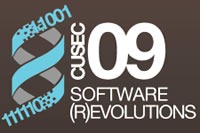 Me and Ballmer at the Microsoft Town Hall in Toronto, October 2009.
Me and Ballmer at the Microsoft Town Hall in Toronto, October 2009.
David “DHH” Heinemeier Hansson recently wrote in the excellent blog Signal to Noise (add it to your reading list if it isn’t there already) that he’d never work for Ballmer.
Since he’s DHH, he doesn’t have to – he’s a principal at the development firm 37signals, whose web apps I like to cite as examples to follow, and the creator of the web framework Ruby on Rails. Unfortunately, most of us aren’t DHH: we can’t all be brilliant game-changing programmers who are also photogenic enough to have the option of becoming a male model when this computer fad blows over. When a Sith Lord from Microsoft comes a-calling with a job offer, we don’t automatically turn it down; we have to mull it over.

I’ve been working for Ballmer (quite indirectly: I’m a fair number of degrees of separation below him on the org chart) for the past twenty months. I can say with complete certainty that out of all the jobs I’ve held – from the job right out of school building multimedia CD-ROMs in Director to working with Cory Doctorow in his dot-com’s evangelism office in San Francisco at the height of The Bubble to various coding jobs from my own consulting shop to Toronto’s worst-run startup to that very brief stint as a go-go dancer at a nightclub – my current gig as Developer Evangelist for The Empire has been my all-time favourite of the bunch. I get to do two things I absolutely love – working with technology and schmoozing with people – and with a fair bit of autonomy: in the setting of my choice, with a set of priorities that I negotiate. I also get to work with some of the brightest and most passionate people I’ve ever met, both inside and outside the company, and it doesn’t hurt that the pay’s quite nice (although, as Dan ink will tell you, money isn’t the primary motivator in this line of work).
 Playing accordion onstage at RailsConf 2007.
Playing accordion onstage at RailsConf 2007.
Until 2008, I’d worked mostly for small companies, many of whom you could fit into a minivan. I might not have considered working for Microsoft, or any large corporation for that matter, had it not been for a little moment that I internally refer to as “The Abercrombie Epiphany”. And oddly enough, it happened at RailsConf 2007, a conference devoted to DHH’s creation Ruby on Rails, where I played an ode to DHH onstage with Chad Fowler at the start of the evening keynote (that’s what’s pictured above, and there’s even a video of the song).
The second day’s opening keynote was about Ruby, Rails and the enterprise, and the crowd was not impressed. A good chunk of the IRC backchannel chatter was devoted to saying “enough with the enterprise already…who cares?” I distinctly remember someone referring to one of the presenters as “trying to be the Rachael Ray of enterprise computing”. The guy leaning against the wall behind me (I’d arrived late, having taken part in the previous night’s bacchanalia) in an Abercrombie & Fitch T-shirt started putting on a hoodie with the letters “A & F” on it and packing up his laptop. “Who uses this stuff, anyway?” he said to me as he picked up his Starbucks cup and walked towards the door. “I’m going back to the Marriott.”
It was probably the fact that he was wearing all that Abercrombie & Fitch – the company vaguely annoys me – that got me thinking about his question, “who uses this stuff anyway?” It turns out he did: he’d flown to Portland, stayed at a chain hotel, used a laptop and conference wifi, drank coffee from the shop with a branch in every mall and seemingly on every corner and bought clothes from a century-old retailer – and the cycles that enabled all that didn’t run two-week-marathon-written code living on 10-dollar hosting, but invisibly and everywhere on systems he didn’t think anyone used.
I wouldn’t give the incident any thought until just over a year later.
 Packing up my stuff after getting laid off from b5media, September 2008.
Packing up my stuff after getting laid off from b5media, September 2008.
What got me thinking about that little Abercrombie & Fitch experience was my getting laid off from b5media during the econopocalypse of summer 2008. I’d been interviewing with a number of companies, all of them small, and blogging the experience as a means of amplifying my job search efforts.
While working on a blog entry, I got an IM from Adam Carter, a tech evangelist at Microsoft. It went exactly like this:
Ever thought about working for The Empire?
(Yes, he referred to Microsoft as “The Empire”.)
Every culture has certain tendencies, and the “I build on Mac OS and deploy to Linux” culture of which I was part led me to instinctively dismiss the idea at first blush. Ridiculous, I thought, and besides, why would they hire me? I haven’t coded any .NET since those trivia games for MAXIM in 2002.
(Yes, I really did that, in an office across the street from the downtown Toronto Hooters. It was like working inside a beer commercial.)
But when my friends John Bristowe (who I’d have voted “most likely to work for Microsoft”) and David Crow (who I’d have voted “most likely to take a dump on Microsoft’s front door”) were making suggestions within the company that they hire me, I had to give Adam’s out-of-the-blue IM a little more thought. And in that thinking, I was reminded of the Abercrombie incident.

Many people would (and did) see working at Microsoft as “the safe move”, but to a guy from the culture of DHH, who’s always worked in all small companies and one medium-sized one and hadn’t used their development tools in over six years, it’s the scary one. When word got around that I was interviewing at Microsoft, I heard a small chorus of voices – one of them that nagging voice of doubt – saying the same thing: “You couldn’t pay me to work for Ballmer”.
But I took the job, anyway. It offered the most challenges, the greatest learning opportunities, a journey to places well outside my comfort zone, and I hadn’t done anything like it before. It was a window into a world I’d only seen from the outside, toward which I’d only made snarky comments from the peanut gallery. It offered me the lever that Archimedes talked about – one big enough to move the world – and a chance to see this computing the Abercrombie guy thought no one used.
(It even gave me the perfect excuse to pull out the Jean Cocteau quote at parties, when explaining my change in career direction: “Since it’s now fashionable to laugh at the conservative French Academy, I have remained a rebel by joining it.")
 Yesterday’s work enviroment – my setup at HacklabTO.
Yesterday’s work enviroment – my setup at HacklabTO.
What is working for Ballmer like? I can’t speak for all of Microsoft’s 90,000 employees, but this Developer Evangelist job is pretty sweet. I’m classified as a mobile worker, which means no cubicle – I’m either working out of the home office, a select bunch of work-friendly cafes, or quite often at HacklabTO, the “hackerspace” in Toronto’s colourful Kensington Market where I’m a member with 24/7 access. Every day’s work environment is different (the picture above shows yesterday’s, at the Hacklab), and this constant flux keeps me going.
I get to noodle with all sorts of interesting tech, from dev tools to cloud computing to game consoles to phones, and I have a hardware guy stocking me with the latest gear. I get to shape the content of a cross-Canada conference that thousands of professional developers across Canada, whose work makes your money move, your electricity flow and your favourite retail stores stay stocked. I get to participate in all sorts of fun stuff, from holding a pre-conference in a train car to having a little fun with Richard Stallman. I get to inspire students as they start their search for jobs in a shaky economy. I get to concentrate in the web, mobile, and open source — fields where the company’s traditional strengths aren’t.
Simply put, I get my shot at changing the world. That’s what DHH is also trying to do – he’s just working it from a different angle. If you want to do that as well, I’m sure you’ll find your own angle, whether it’s homesteading in your own indie software company working out of a cafe to doing it as a part of a Fortune 500 company. DHH is DHH, and you are you, and while he could never work for Ballmer, you might like it like I do, and that’s okay. After all, that’s why the saying goes “Do not follow in the footsteps of the masters; seek what they sought instead.”
This article also appears in Canadian Developer Connection.



 Playing accordion onstage at RailsConf 2007.
Playing accordion onstage at RailsConf 2007. Packing up my stuff after getting laid off from b5media, September 2008.
Packing up my stuff after getting laid off from b5media, September 2008.
 Yesterday’s work enviroment – my setup at HacklabTO.
Yesterday’s work enviroment – my setup at HacklabTO. Microsoft was a sponsor of
Microsoft was a sponsor of  As I mentioned in
As I mentioned in 

